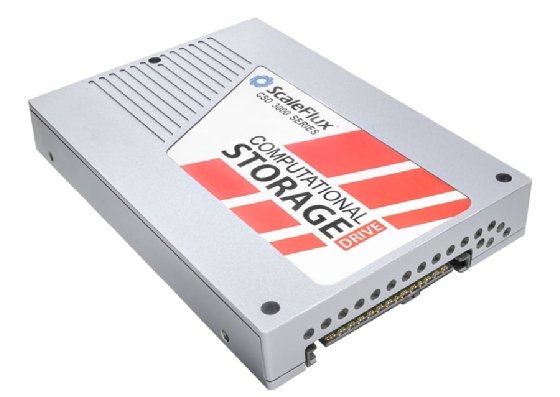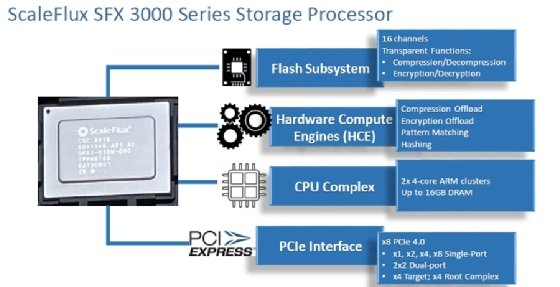
Getty Images
ScaleFlux debuts SFX 3000 series and SSDs
ScaleFlux showcased its new SFX 3000 computational storage suite, including a custom chip and new SSDs with higher performance along with compression and encryption.
ScaleFlux demoed its new SFX 3000 storage processing units, which are used in its higher performance computational storage drives, at this week's Open Compute Project Global Summit in San Jose, Calif.
The vendor has added encryption and programmable cores to the new 3000 series while keeping features from its 2000 series such as transparent compression. ScaleFlux is using the SFX 3000 in its expanded SSD line the CSD 3000, a higher performing computational drive, and the NSD 3000, the vendor's first NVMe SSD for more general use.
The vendor also launched the CSP 3000 accelerator card to bring computational storage features to existing drives, and CSAware software, which will give users a higher level of customization over ScaleFlux products.
Computational storage moves compute into the storage drive, closer to where the data resides. Doing so lowers latency by shortening the distance between the processor and the data, offloads CPU-intensive processes like compression and encryption to the processor in the drive, and offloads application processes to the drive CPU, Marc Staimer, president of Dragon Slayer Consulting, wrote in an article.
Randy Kerns, a senior analyst at Evaluator Group, said that the demand for computational storage, a small market when compared to SSDs overall, is increasing, particularly for high-performance computing and specialized applications such as artificial intelligence and machine learning.
"Computational storage is a developing area," Kerns said. "It has some very interesting high-value use cases now, and it's going to expand."
SFX 3000 series
ScaleFlux's latest generation computational storage processor is a custom designed application-specific integrated circuit (ASIC), versus the field-programmable gate array (FPGA) that was in the product for the 2000 series, according to JB Baker, vice president of marketing at ScaleFlux.
The ASIC has four main parts: the controller, the hardware engines, the CPU, and the interface, which is now PCIe Gen 4. Making the ASIC in-house allowed ScaleFlux to add encryption and programmable cores.
The 16-channel Flash controller has standard SSD functions, a path from the host to the storage. The controller is also where its transparent storage compression and decompression happen. The compression is automatic and creates less data to store, which increases performance and endurance while taking strain off the host CPU. Data encryption and decryption also happen in the controller to provide added data protection while relieving the system CPU.
Hardware engines perform compression and encryption offloading, writing it somewhere other than directly to storage. Moving these data-intensive tasks away from core storage functionality is one of the ways the product increases performance, Baker said.
There are eight programmable ARM cores in the CPU, configured into two quad-core clusters, with up to 16 GB of DRAM.
Finally, the PCIe Gen 4 interface offers higher performance. The interface is PCIe 4x4/x8 supporting up to eight PCIe lanes and single- and dual-port drives.
New SSD options
The new line of SSDs that ScaleFlux rolled out are built on the SFX 3000.
The new flagship computational storage SSD is the CSD 3000, which provides more than twice the endurance and performance compared to other enterprise NVMe SSDs at the same capacities, according to ScaleFlux. It comes in the standard form factors, including U.2, HHHL AIC and E.1x, along with enterprise-grade 4 TB, 8 TB and 16 TB of raw capacity.
The CSD 3000 is offered with both TLC and QLC NAND. Baker said the QLC adds density and cost improvement. With the compression engines and controller, ScaleFlux has seen QLC -- typically outperformed by TLC in endurance, read and write performance and latency -- perform as well as TLC.

Kerns echoed Baker's point, saying most issues with QLC, particularly endurance, have been addressed in the last year.
Offered in 3.84 TB and 7.68 TB fixed capacities, the NSD 3000 has the performance and endurance benefits of the CSD 3000 but not the other aspects of computational storage, such as the programmable cores. ScaleFlux claimed it has two times the performance and endurance in mixed read and write workloads and random write workloads compared to similar class drives.
ScaleFlux also unveiled its CSP 3000, an accelerator card that enables SFX 3000 computational storage processors to be used with any drives, not just ScaleFlux products, Baker said. All eight processing cores are programmable for user applications, since there is no storage on the card to manage. The CSP can split the PCIe x8 into two x4, four lanes connect to the server host and the other four lanes connect to a coprocessor or FPGA to further enhance compute capabilities.
Still in development, the ScaleFlux CSAware software could make it easier for users to take advantage of the hardware in the drives and accelerator card. Baker said the company is still gathering input from users, but CSAware will have software RAID; an optimized KV store that uses the compression to consume less host DRAM for higher performance; and optimizations to the B-tree to reduce write amplification without sacrificing storage cost or performance.
Kerns said the CSAware software adds value by exploiting the characteristics of the ScaleFlux ASIC, enabling users to customize applications that utilize the processors in computational storage, he said.

Place in the market and pricing
ScaleFlux said the CSD 3000 drives will come at a premium, and the NSD 3000 will be competitively priced to similar enterprise NVMe SSDs. The compression abilities will expand capacity in the units, lowering the overall data storage cost, according to Baker.
But cost isn't the only overhead; power consumption and heat generation are also factors to consider. Baker said the new drives stay within the power envelopes of the given form factors and use less power per I/O, relying on saved power in the controller.






